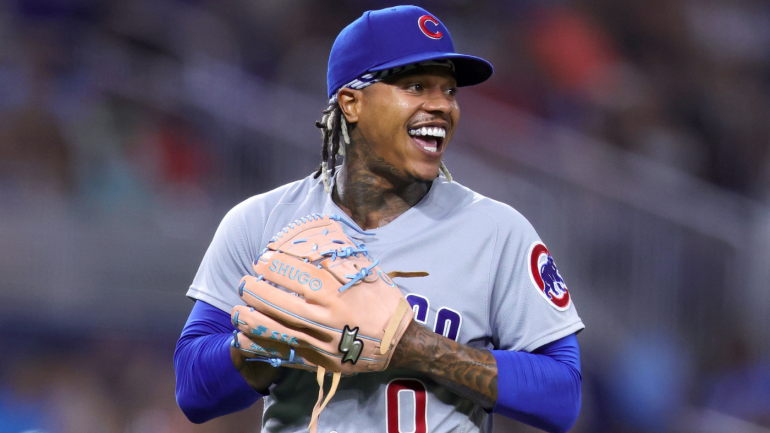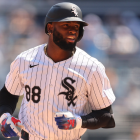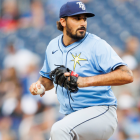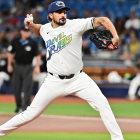
The 2023-24 MLB offseason has begun and several important deadlines are coming up. Come Monday, teams and players will have to make contract option decisions. Club options are controlled by the team, player options and opt outs are controlled by the players, and mutual options are sort of pointless. They're mostly a way to push money to next year.
Some option decisions are no-brainers, like the Giants picking up their $10 million club option for Alex Cobb. He'll miss the start of next season following hip surgery, but even then $10 million is a bargain for a pitcher of his caliber. Expect Eduardo Rodriguez to opt out of the three years and $49 million remaining on his contract with the Tigers. There's more money to be made in free agency.
With that in mind, here now are the five most interesting contract options of the 2023-24 offseason, listed alphabetically.
1. Tim Anderson, White Sox - team declined option
What once looked like one of the best contracts in the sport is suddenly a question. Anderson, who turned 30 in June, had a dreadful 2023, slashing .245/.286/.296 with one home run -- one! -- in 524 plate appearances. His 61.1% ground ball rate was highest among all qualified hitters and his defense graded out very poorly. Anderson was a minus-2.0 WAR player in 2023.
The White Sox hold a $14 million club option on Anderson. It includes a $1 million buyout, so it's a $13 million decision. On one hand, Anderson was awful in his most recent season. On the other hand, Anderson hit .318/.347/.474 from 2019-22, and guys who can do that are few and far between. Is he worth a $13 million roll of the dice to see whether he can rediscover that form?
Keep in mind this offseason's free agent class is very thin, particularly in middle infielders. Anderson and Amed Rosario are the only full-time middle infielders among our top 50 free agents, and both had down years. Here are the top free agent full-time middle infielders by 2023 WAR:
- Elvis Andrus: 1.1 WAR
- Brandon Crawford: 0.4 WAR
- Paul DeJong: 0.3 WAR
- Adam Frazier: 0.3 WAR
- Amed Rosario: 0.2 WAR
As bad as he was this season, Anderson might have trade value at $14 million. Would you rather trade a prospect for Anderson or try to find a shortstop in this free agent class? This year's performance says the White Sox should decline the option. Anderson's track record and the offseason's middle infield market suggest the decision is much less obvious.
Prediction: The White Sox decline the option. Owner Jerry Reinsdorf is not exactly known for running high payrolls, and gambling $13 million on a player bouncing back from a dreadful season doesn't seem like his style. Even when the player is a homegrown All-Star and popular with the fan base, like Anderson.
2. Chad Green, Blue Jays
Thanks largely to the galaxy-brain-ization of front offices, contract options are becoming more and more complicated. Now there are options that depend on certain conditions, and in some cases those conditions are tied to other options. Toronto signed Green, once a stalwart reliever with the Yankees, to a complicate contract last offseason, when he was still rehabbing from Tommy John surgery.
The Blue Jays paid Green a $2.25 million salary in 2023. The 32-year-old righty completed his rehab, joined the team once rosters expanded in September, and allowed 10 runs in 12 innings. To be fair, Green got lit up for four runs in two-thirds of an inning in his season debut (in Coors Field). He was much more effective the rest of the way, including in the postseason.
Anyway, here are the options in Green's contract:
- The Blue Jays have a three-year, $27 million club option. This decision comes first.
- If the Blue Jays decline that club option, Green has a one-year, $6.25M player option.
- If Green declines the player option, the Blue Jays have a two-year, $21M club option.
Got all that? Three years and $27 million is high-end setup man money. Think Rafael Montero last offseason. One year and $6.25 million is veteran middle reliever money. Andrew Chafin and the recently retired Trevor May signed for a similar amount that winter. A this point in his career, Green probably falls into the Chafin/May bucket more than the Montero bucket.
The thing is, Green would likely get more than $6.25M as a free agent this offseason, but also less than $27 million. He threads the needle between not worth Toronto's two club options but worth more than his player option. The Blue Jays have money to spend and they know Green's post-Tommy John surgery health better than anyone. They might be willing to pay that salary.
Prediction: Boy, I really have no idea. This is a tricky one. I will say the Blue Jays decline the three-year club option, Green declines his player option, then the Blue Jays pick up the two-year club option. Essentially, I think Toronto would rather have Green for two years at $10.5 million a pop than three years at $9 million a year. My guess is they'd rather pay the extra $1.5 million annually than be on the hook for his age-35 season in 2026.
3. Liam Hendriks, White Sox - team declined option
Hendriks made his triumphant return from stage 4 non-Hodgkin's lymphoma on May 29. Things didn't do especially well (two runs in one inning), but who cares? Hendriks made it back to the mound, picked up his first win of 2023 on National Cancer Survivors Day, and served as an inspiration to many. If he's not the AL Comeback Player of the Year, then what are we even doing here?
Alas and alack, this sport can be cruel, and Hendriks blew out his elbow in mid June and required Tommy John surgery. The timing of the surgery means he will miss most, if not all, of 2024. "My goal is to be able to pitch next year and then be able to have a relatively normal offseason," Hendriks told MLB.com in August. And you going to bet against him? I won't.
Baseball is a business and the White Sox have an option decision to make on Hendriks this offseason. It's a bit convoluted:
- $15 million club option with a $15 million buyout.
- If the option is declined, the buyout is paid out in 10 annual installments of $1.5 million from 2024-33.
Hendriks gets his $15 million either way. For the White Sox, it's a question of whether they want to pay it all in 2024, or spread it out over the next 10 years. And considering Hendriks will miss most of 2024, it stands to reason they will spread the $15 million across 10 years. If he was healthy and able to pitch, they may have paid the $15 million in 2024 and kept him. That's not the case though.
Prediction: The business part of his game can be harsh. Since Hendriks won't pitch much next season, if he pitches at all, it makes sense for Chicago to decline the option and pay the $15 million across the next 10 years. My bet is Hendriks would then sign a two-year contract with a team that will rehab him in 2024, and look to turn him loose in 2025.
4. Marcus Stroman, Cubs - opted out
As recently as July 15, Stroman was an NL Cy Young candidate, having pitched to a 2.88 ERA in 20 starts and 118 2/3 innings. He got hammered in his next three starts though (18 runs in 10 innings), then landed on the injured list with right hip inflammation. Stroman's rehab was slowed in August, and, when he returned in September, he allowed eight runs in eight innings as a reliever.
The option decision is Stroman's. He has one year and $21 million remaining on his contract and he can opt out and become a free agent. In mid July, it was a no-brainer. Obviously Stroman would opt out. After the hip issue and stumble to the finish though? Now it's not so cut and dried. Taking the $21 million and hoping for better health leading into free agency next winter has some appeal.
Stroman, 33 next May, is a known quantity. He is one of the game's premier ground ball pitchers and he generally pitches deep into games because he's so efficient. There was a shoulder issue last year in addition to this year's hip problem though, so injuries are beginning to pile up, and pitchers usually don't get healthier in their 30s, even ones as athletic with their deliveries as Stroman.
Prediction: I think he'll opt out. Even with the hip injury, this offseason might be Stroman's last best chance to get another long-term contract. Waiting a year would mean assuming a lot of injury risk, and entering the market as a pitcher a few months away from his 34th birthday. The free agent class is thin, there will be greater demand for pitching than supply, which will work in Stroman's favor.
5. Michael Wacha, Padres - team declined option
It was not until the early days of spring training that the Padres signed Wacha, who gave the club 134 1/3 innings with a 3.22 ERA in 2023. Considering he only took home $7.5 million this year, that was a nifty pickup for San Diego. Now comes decision time. Wacha is another player with a less-than-straightforward set of options in his contract. Here's his situation:
- The Padres have a two-year, $32 million club option.
- If the club option is declined, Wacha has a three-year, $18.5 million player option.
San Diego reportedly took out a $50 million loan to cover short-term expenses in September, including player payroll, and they are planning to reduced payroll to $200 million in 2024. That will require shedding about $50 million, which will be easy to do if they let Blake Snell and Josh Hader leave as free agents, and trade Juan Soto. That, of course, would make the team considerably worse.
If the Padres are that desperate to trim payroll, they could decline their club option for Wacha, and he would likely decline his player option and go into free agency. With the year he just had, Wacha should be able to clear $18.5 million guaranteed as a free agent, especially in this free agent class. The Padres could do that. They would also then have to replace Wacha.
Prediction: San Diego should just pick up the club option. They're going to need someone to pitch next season and $16 million a year is No. 3-4 starter money in free agency. Wacha's worth it. And, even if they don't want to keep him, there might be a trade market for Wacha at that salary. The Padres could pick up the option and then cash Wacha in as a trade chip.
Honorable Mentions
Josh Bell, Marlins: Bell has one year and $16.5 million remaining on his contract, and he can opt out this offseason. The market is generally unkind to bad defensive first basemen, though Bell hit well after being traded to Miami. I think he'll opt out.
Michael Conforto, Giants: After missing 2022 with a shoulder injury, Conforto returned in 2023 and was a league average hitter. He picked up the right to opt out of his $18 million salary for 2024 when he reached 350 plate appearances. Even after a so-so season, the 30-year-old Conforto is expected to opt out.
Andrew Heaney, Rangers: Heaney's contract includes a $13 million player option, and had he thrown an additional 2 2/3 innings during the regular season and reached 150 innings, the option value would have increased to $20 million. These days $13 million doesn't buy you much in free agency. Lefties who miss bats are always in demand, and Heaney didn't hurt his free agent case with his Game 4 performance in the World Series. Exercised player option.
Lance Lynn, Dodgers: Including the postseason, Lynn allowed 48 home runs in 186 1/3 innings in 2023, which sources say is bad. The thing is, Los Angeles is so desperate for pitching and the free agent market is so bad that picking up Lynn's $18 million club option ($1 million buyout) is not crazy. He eats innings and perhaps Los Angeles can coach up over the winter and during spring training. The bet here is the Dodgers decline the option and, if anything, try to re-sign Lynn at a lower salary. Team declined option.
Nick Martinez, Padres: Like Wacha, Martinez has a "double" option in his contract. The Padres have a two-year, $32 million club option, and if they decline that, Martinez has a two-year, $16 million player option. He's proven to be a valuable and versatile member of the pitching staff the last two years, though that club option might be pricey for a team that wants to cut payroll. Both sides declined option.




























